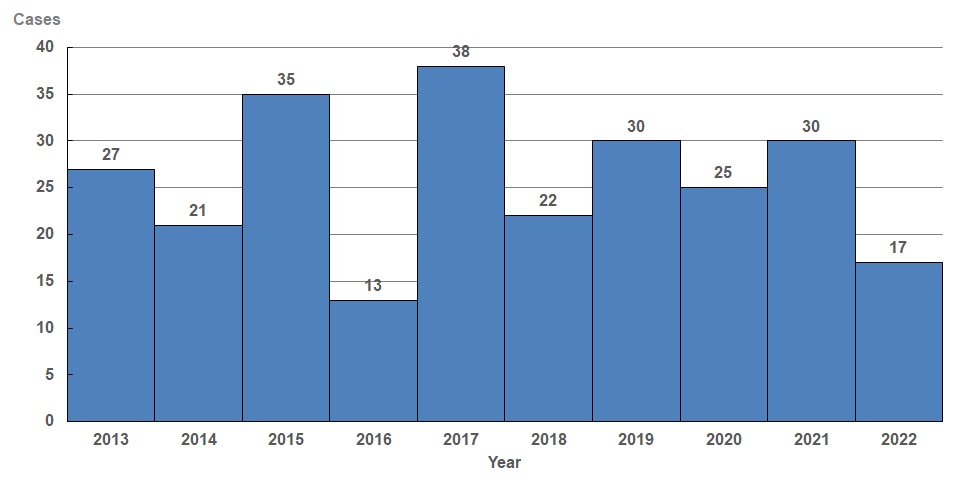- About CDC
- Diseases & Conditions
- Programs & Campaigns
-
Data & Statistics
- Taiwan National Infectious Disease Statistics System
- Statistics of HIV/AIDS
- Disease Surveillance Express
- Influenza Express
- National Notifiable Disease Surveillance Report
- Weekly Report of Enterovirus Infection
- Taiwan Healthcare-associated infection and Antimicrobial resistance Surveillance System
- Taiwan CDC Open Data Portal
- International Cooperation
-
About CDC
- Diseases & Conditions
-
Programs & Campaigns
-
Data & Statistics
- Taiwan National Infectious Disease Statistics System
- Statistics of HIV/AIDS
- Disease Surveillance Express
- Influenza Express
-
National Notifiable Disease Surveillance Report
National Notifiable Disease Surveillance Report
-
Weekly Report of Enterovirus Infection
Weekly Report of Enterovirus Infection
- Weekly Report 2025
- Weekly Report 2024
- Weekly Report 2023
- Weekly Report 2022
- Weekly Report 2021
- Weekly Report 2020
- Weekly Report 2019
- Weekly Report 2018
- Weekly Report 2017
- Weekly Report 2016
- Weekly Report 2015
- Weekly Report 2014
- Weekly Report 2013
- Weekly Report 2012
- Weekly Report 2011
- Weekly Report 2010
- Weekly Report 2009
- Weekly Report 2008
- Taiwan Healthcare-associated infection and Antimicrobial resistance Surveillance System
- Taiwan CDC Open Data Portal
- International Cooperation
- News
- Privacy Policy
- Security Policy
- Government Website Open Information Announcement
- Copyright Notice on Health Educational Materials
Endemic typhus fever, also known as murine typhus, is caused by Rickettsia typhi. Endemic typhus fever is an infectious disease, and the clinical manifestations are very similar to epidemic typhus. The incubation period is 1–2 weeks (usually 12 days). This disease is usually acute and mild, with a skin rash, fever, chills, fatigue, and muscle pain. Rash occurs in 50%-80% of patients, however, it typically occurs around day 5 of illness and lasts 1-4 days, initially on the upper trunk, followed by spread to the entire body, but usually not to the palms, or soles. Most people will recover without treatment, but some cases may be severe. When left untreated, severe illness can cause damage to one or more organs including the liver, kidneys, heart, lungs, and brain. Complications such as acute renal failure and respiratory failure can occur but are not common. The case-fatality rate for all ages is less than 5%. Presence of flea and absence of lice infestation, geographic and seasonal distribution, and sporadic occurrence of the disease help differentiate it from epidemic typhus. Animal reservoirs include wild rats, mice, and other rodents. Rat fleas and probably cat fleas transmit the agent to humans.
Endemic typhus fever occurs in most parts of the world, particularly in the tropical and subtropical areas. It may be found among people in close contact with rats or areas where rats live. Humans exposed to flea-infested cats, dogs, and peridomestic animals while traveling in endemic regions are at most risk for murine typhus. Endemic typhus fever occurs mainly in sporadic cases, and incidence is probably underestimated in the more endemic regions. Populations of the flea vector may rise during the summer months in temperate climates, subsequently increasing the incidence of endemic typhus fever.
Epidemiology
In Taiwan, there were sporadic cases of endemic typhus fever occurring throughout the year. Most cases of endemic typhus fever are reported in Kaohsiung City, Pingtung County, Changhua County, Taichung City and Tainan City during 2018-2022. Early detection of infected cases can reduce the risk of widespread transmission.

Figure: Endemic typhus fever cases in Taiwan, 2013-2022.
- Taiwan National Infectious Disease Statistics System–Endemic Typhus Fever
- Self–reporting through toll–free 1922 hotline or local public health authority.
Prevention and Control
- The important strategy to prevent endemic typhus fever is to avoid bites by flea.
- (1)It is important that all pets are treated for fleas, including indoor and outdoor pets, and that the environment is treated as well.
- (2)The pets are treated by using pyrethroid insecticides or flea control products to remove the fleas that are on the pets.
- (3)To keep the house clean by vacuuming thoroughly and regularly, especially below drapes, under furniture edges, and where the pets sleeps. It is estimated that vacuuming can remove most flea eggs.
- Controlling the rodent population which are known to carry arthropods.
- (1)No way for mouse to enter: to seal the mouse hole around the house and all the gaps to prevent the mouse to enter.
- (2)No food for mouse to eat: to seal the food and drink and discard the garbage that contain the food debris immediately to prevent the mouse to eat.
- (3)No space for mouse to stay: to remove the junk, waste and weeds around the house and seal the trash can to prevent the mouse to stay.
FAQs
- What is endemic typhus fever?
- Endemic typhus fever is an infectious disease, clinically very similar to epidemic typhus. The incubation period is 1–2 weeks (usually 12 days). This disease is usually acute and mild, with headaches, chills, prostration, fever, muscular pain and skin rash.
- How are endemic typhus fever transmitted?
- The causative agent, Rickettsia typhi, is transmitted by the rat or cat flea which is infected while feeding on the blood of infected rat or cat. A Rickettsia–harboring flea bites a second host to engage in a blood meal. The flea defecates as it eats; when the host scratches the site, and the Rickettsia–laden excrement is inoculated into the bite wound. The Rickettsia travel to the bloodstream and rickettsemia develops. Inhaling with infectious material may also cause infection.
- How to prevent the endemic typhus fever?
- Avoiding flea bites is the most important prevention method. To remove fleas, treat the pets and the environment of house with pyrethroid insecticides. To prevent flea infestations, keep the rodents and stray animals out of the house and the work environment.
More Information
Images

Attached Files
About CDC
Data & Statistics
- Taiwan National Infectious Disease Statistics System
- Statistics of HIV/AIDS
- Disease Surveillance Express
- Influenza Express
- National Notifiable Disease Surveillance Report
- Weekly Report of Enterovirus Infection
- Taiwan Healthcare-associated infection and Antimicrobial resistance Surveillance System
- Taiwan CDC Open Data Portal

